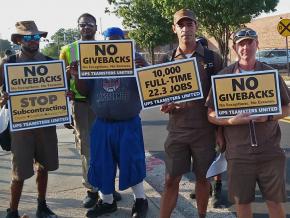Don’t let Hoffa impose this illegitimate contract
reports on the chaotic outcome of the Teamsters contract vote at UPS — and looks at what comes next and what it will take to build real rank-and-file power.
UPS TEAMSTERS rejected a tentative five-year national contract agreement by a 54 percent margin, according to votes tallied on October 5. Members also rejected a separate UPS freight contract by 62 percent.
But that doesn’t matter to Teamsters General President James P. Hoffa.
The Hoffa administration and its chief negotiator Denis Taylor are trying to impose the contract on the 260,000 members in its package division by using a clause in the union constitution that requires 50 percent of eligible members to vote in order for a majority to rule. If that threshold isn’t reached, then two-thirds of those voting have to vote “no” in order to reject a tentative agreement.
This undemocratic language is in the Teamsters constitution is protecting an unpopular and conservative administration that is unwilling to organize a fight against UPS.

In addition to the vote rejecting the national contract, numerous supplements to the overall agreement were voted down — and these are also being imposed on UPS Teamsters.
IN THE days after the vote count was announced, the response of the Hoffa administration caused chaos and confusion.
Members got mixed messages about whether the union was going back to the negotiating table or simply making a few changes and imposing the contract on members. In addition, the company issued its own statement saying that it was “disappointed” the agreement wasn’t ratified and stating that it would go back to the negotiating table.
Needless to say, the Hoffa administration’s ham-fisted assault on the right of the rank and file to decide on a contract that affects their lives at work every day has angered Teamsters across the country.
As members try to figure out what happened, there have been many ideas flying around about how to respond, ranging from leaving the union to a wildcat strike. Most Teamsters fall in between these two positions and are still trying to make sense of what has happened.
As this article was being written, the situation is fluid, with new information and news surfacing every few hours. But there can be no doubt that the Teamsters bureaucracy is trying to ram through a deal the company is happy with.
On October 8, after Taylor announced that he would apply the undemocratic two-thirds rule to ratify supplements rejected by members, UPS Teamsters United, a grassroots campaign organized to oppose concessions, explained how Taylor is “making up the rules” as he goes along:
In June 2013 [during negotiations over the last contract], 10 supplements and riders were rejected by less than two-thirds, and had less than 50 percent participating in the vote. Every single one was renegotiated, and re-voted...
Now, Taylor claims that respecting the majority vote of the members violates the Teamster constitution. He’s either lying, ignorant or just determined to do the company’s dirty work at whatever the cost. No national contract has ever been ratified after a majority of members voted “no” since the revised two-thirds rule went into effect in 1987...
International Union Vice Presidents are calling for Hoffa to halt the ratification of the UPS contract and hold an emergency meeting of the General Executive Board.
UPS Teamsters demand that the International Union return to the bargaining table and hold a vote on an improved contract offer.
ON THE ground, some Teamsters are blaming those who didn’t vote as the problem, rather than Hoffa and Taylor, who are forcing the contract on us.
First, the idea that 50 percent of eligible voters must vote in order for a simple majority to rule would mean that most elections in the U.S. would be nullified. Turnout rates of eligible voters rarely come close to that number. Second, the percentage of members who voted was actually up from the previous contract.
But more importantly, we should look at why some members aren’t as involved in the union as they could be.
Voting in elections is important, but a union’s real strength is in the day-to-day struggles at the workplace. An active rank and file, with elected stewards and business agents, that is able to discuss and debate the constant battles with management is a crucial step for a stronger union locally and nationally.
If workers feel like management calls all the shots, they have less confidence in themselves and their union officials.
One reason that many UPS workers don’t vote is that UPS relies on a conveyor belt of low-paid new hires who usually quit after a few weeks or months. Many locals don’t integrate these new workers into the union, but only collect their dues money.
UPS management abuses this army of part-timers that typically isn’t as active in the union and tends to vote less than full-time workers. Thus, achieving a 50 percent threshold is a difficult task when many union officers and stewards aren’t educating the membership about their rights immediately.
Instead of blaming workers who didn’t vote, we have to look at why these workers are ignored by most locals — and then blamed for their “apathy” if they don’t vote.
Many part-timers will tell you that union officials are only interested in the full-time workers, especially drivers. This sentiment among low-paid part-timers — trying to survive on almost minimum wage, with hardly any chance for an inside full-time job — breeds resentment.
Back in the late 1970s, UPS workers made approximately the same pay per hour, whether they were part time or full time. The union gave up that rough equality over the years.
We all are important to the operation of the company, and equal pay would encourage solidarity with each other, instead of the many-tiered pay rates that separate us today. The way to bring unity is to raise the pay for those getting far less and decrease the gap in wages.
In my building, it can take over 14 years to get a full-time inside job. Of course, UPS needs full-time drivers due to the increasing workload, but many workers aren’t qualified or don’t want to drive. They shouldn’t be punished with far less pay because of that.
The trucks don’t load or unload themselves, and inside workers are just as important as drivers. They should be recognized for that with a demand for the same pay rates, just like in the past.
UPS IS notorious for treating workers like machines who are capable of constantly increasing productivity, despite the physical and mental toll that eventually breaks down many of us.
Management uses technology, not to make our work easier, but to force us to be even more productive — whether that means increasing stop counts for package car drivers, or installing new automated sorts that can make the packages flow so fast for inside workers that no one can keep up the pace without injuring themselves.
The excessive overtime imposed by UPS also means that many workers are used to working long hours. They rely on being paid time and a half.
Our raises haven’t kept up with the cost of living over the years. Instead, too many of us have been conditioned to working the long hours that our great-great-grandparents did more than 100 years ago. This has become the new normal, and it shapes how UPS workers see their jobs.
What we need are more full-time jobs, both driving and inside work, that pay top scale. We need an end to subcontracting. We need to force UPS to create thousands of full-time top-scale driver jobs, and not the union-backed 22.4 hybrid driver jobs that would pay $5 less an hour with less workplace protection.
This contract’s pay raises for part-timers and full-timers aren’t high enough. Even nonunion Amazon workers will now make more per hour in wages than newly hired unionized Teamsters.
Also, we should demand that the company stop paying bonus money for new part-timers, which is unfair and creates divisions among part-timers who have been working at UPS for years, but will make less than new hires who achieve the bonus pay. Instead, we need a minimum of $15 an hour and bump-up raises for current part-time workers.
We need to stop speedups and harassment at work. That would first of all show those workers who are cynical or apathetic that the union — which is us — is willing to take on management, and not allow them to constantly intimidate or threaten us.
The same is true for stopping the obsessive overtime imposed on drivers, like the 70-hour workweek implemented for peak season in November and December 2017.
Strategies that have previously worked in advancing these demands include workers collectively slowing down the pace, also known as “work to rule” or “working safe.” This means a collective of workers refusing to meet arbitrary “production” quotas that squeeze as much labor power as possible from each one of us to maximize profits for shareholders and to outcompete the competition, like FedEx and the ever-expanding giant, Amazon.
The national 1997 UPS strike proved that the best way for us to win is to shut down the whole operation so that no packages move — because without our labor, UPS management and its machines can’t deliver.
EVEN THOUGH our side won the majority of votes in the ratification, it’s still a problem that the vote was close.
Our union is divided. There’s a layer of workers who either like what Hoffa is doing or are so discouraged with the union that they don’t think a fightback is possible.
The success of the “vote no” campaign at several hubs showed the potential for members organizing together to begin rebuilding our union’s strength from the bottom up. In some locals, members showed their determination to stand up and demand a better contract — and now they can build on the networks that came together to make our union recognize that vote.
For example, in New York City’s Local 804, where members organized an active “Vote no” campaign, some 95 percent of members voted against the contract offer. Now, Local 804 is circulating a petition calling for a new contract and a new vote.
Teamsters for a Democratic Union, a reform group made up of rank-and-file Teamsters and officers, has issued a “Five Ways that UPSers Can Fight Back” statement in response to the Hoffa administration’s effort to push through this contract. UPS Teamsters United is circulating a petition demanding that Hoffa honor members’ votes and go back to the bargaining table.
On social media, workers are discussing other ideas at their hubs, including demonstrations.
Demonstrations would be a first good step to show UPS’s top brass and the Hoffa administration that we are mad at this imposition of an austerity contract, especially when the company raked in almost $5 billion in profits in 2017. This is a company that can afford to pay us more and hire more workers.
We need to organize Amazon, but if newly hired UPS Teamsters make less than Amazon workers, why would Amazon workers want to join with us?
The best way to organize the unorganized is to win big at already unionized companies. Nonunion workers will want to join us, but not if our union leaders impose a bad contract that we voted down.
We can’t let Hoffa get away with this. UPS will take this as a green light to go after us even harder. This contract fight isn’t over if we organize and put intense pressure on the Hoffa administration and UPS.


